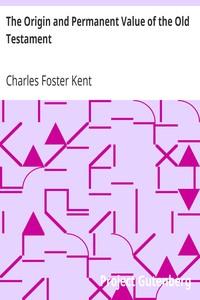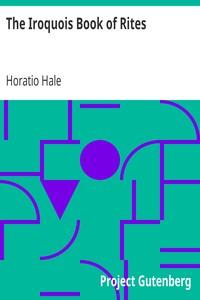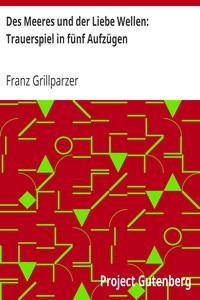Read this ebook for free! No credit card needed, absolutely nothing to pay.
Words: 48424 in 16 pages
This is an ebook sharing website. You can read the uploaded ebooks for free here. No credit cards needed, nothing to pay. If you want to own a digital copy of the ebook, or want to read offline with your favorite ebook-reader, then you can choose to buy and download the ebook.


: The Origin and Permanent Value of the Old Testament by Kent Charles Foster - Bible. New Testament Criticism interpretation etc.; Bible. Old Testament Introductions; Bible. New Testament History Judaism
XL THE WRITINGS OF ISRAEL'S PHILOSOPHERS
THE ECLIPSE AND REDISCOVERY OF THE OLD TESTAMENT
The events of Hebrew history, and its heroes --Abraham, David, Elijah-- were all familiar to him. The Old Testament was the background of a large portion of the Sermon on the Mount. From Deuteronomy vi. 4, 5, and Leviticus xix. 18 he drew his marvellous epitome of all law and duty. In the wisdom literature, and especially in the book of Proverbs, he found many of those practical truths which he applied to life with new authority and power. From the same storehouse of crystallized experience he derived certain of those figures which he expanded into his inimitable parables; he adopted also, and put to new use, the effective gnomic form of teaching of the wisdom school. As in the mouth of his herald, John the Baptist, the great moral and spiritual truths, first proclaimed by the ancient prophets, live again on the lips of Jesus. At every point in his teachings one recognizes the thought and language of the older Scriptures. At the moments of his greatest temptation and distress, even in the last agony, the words of the ancient law and psalms were on his lips and their consoling and inspiring messages in his mind.
What is so strikingly true of Jesus is equally true of the apostles and disciples who have given us the New Testament books: the atmosphere in which they lived, the thoughts which they thought, and the language in which they spoke, were those of the Old Testament. Not bowing slavishly before it, as did their Jewish contemporaries, but with true reverence, singling out that which was vital and eternal, they made it the basis of their own more personal and perfect message to humanity. But for them, and for the early Church, until at least the middle of the second Christian century, the only scriptures regarded as authoritative were those of the Old Testament. Even then, only gradually, and under the pressure of real needs, were different groups of Christian writings added and ascribed an authority equal to that of the older Scriptures.
Throughout the Middle Ages and in the eyes of the Protestant reformers the two great divisions of the Bible continued to command equal respect and attention. From the Old Testament and its reflection in the teachings of Paul, Puritanism and the theology of the past three centuries derived most of that which revealed their strength as well as their weakness. From the law, the prophets, and the book of Proverbs they drew their stern spirit of justice, their zeal for righteousness, and their uncompromising condemnation of everything that seemed to them wrong. Their preachers nobly echoed the thunders of Sinai and the denunciations of an Elijah, an Amos, and an Hosea. They often failed, however, to recognize the divine love which prompted the stern words of the prophets, and to see that these denunciations and warnings were simply intended to arouse the conscience of the people and to make them worthy of the rich blessings that God was eager to bestow. Misinterpretation of the spirit of the later Old Testament reformers, who dramatically portrayed Jehovah's hatred for the abominable heathen cults in the form of commands to slaughter the peoples practising them, frequently led the Puritan fathers to treat their foes in a manner neither biblical nor Christian. To this narrow interpretation of the letter rather than the spirit of the Old Testament, and the emphasis placed upon its more primitive and imperfect teachings can be directly traced the worst faults of that courageous band who lived and died fighting for what they conceived to be truth and right.
It is undoubtedly true that during the past two decades the Old Testament has in fact, if not in theory, been assigned to a secondary place in the life and thought of Christendom. This is not due to the fact that the Christ has been exalted to his rightful position of commanding authority and prestige. All that truly exalts him likewise exalts the record of the work of his forerunners which he came to bring to complete fulfilment and upon which he placed his eternal seal of approval. Rather, the present eclipse of the Old Testament appears to be due to three distinct causes. The first is connected with the reaction from Puritanism, and especially from its false interpretation of the Bible. Against intolerance and persecution the heart of man naturally rebelled. These rang true neither with life nor the teaching of Jesus. Refuge from the merciless and seemingly flawless logic of the earlier theologians was found in the simple, reassuring words of the Gospels. The result was that, with the exception of a very few books like the Psalter, the Old Testament, which was the arsenal of the old militant theology, has been unconsciously, if not deliberately, shunned by the present generation.
Little wonder that many who heard only from afar the ominous reports of the digging and delving, and vague rumors,--all the more terrifying because vague,--either leaped to the conclusion that the authority of the Old Testament had been undermined or else rallied in a frantic effort to put a stop, by shouting or compulsion, to the seemingly sacrilegious work of destruction. When the history of the Higher Criticism of the Old Testament is finally written, it will be declared most unfortunate that the results first presented to the rank and file of the Christian Church were, as a rule, largely negative and in many cases relatively unimportant. In their initial enthusiasm for scientific research scholars, alas! sometimes lost the true perspective and failed to recognize relative values. The date, for example, of Isaiah xl.-lv. is important for the right understanding and interpretation of these wonderful chapters, but its value is insignificant compared with the divine messages contained in these chapters and their direct application to life. Moreover, instead of presenting first the testimony and then patiently pointing out the reasonableness and vital significance of the newer conclusions, scholars sometimes, under the influence of their convictions, made the fatal mistake of enunciating those conclusions simply as dogmas.
The third reason why the Old Testament has suffered temporary eclipse in so many minds is more fundamental; it is because of the difficulties in understanding it. The background of the New Testament is the Roman world and a brief century with which we Western readers are well acquainted; but the background of the Old is the ancient East--the age and land of wonder, mystery, and intuition, far removed from the logical, rushing world in which we live. The Old Testament contains a vast and complex literature, filled with the thoughts and figures and cast in the quaint language of the Semitic past. Between us and that past there lie not merely long centuries, but the wide gulf that is fixed between the East and the West.
With three such distinct and powerful currents--reaction, suspicion, and misunderstand--bearing us from the Old Testament, it might be predicted that in a decade or two it would lie far behind our range of vision. Other forces however are, in divine providence, rapidly bringing it back to us again, so that we are able to understand and appreciate it as never before since the beginning of the Christian era. The chasm between us and it is really being bridged rather than broadened. The long centuries that lie back of the Old Testament have suddenly been illuminated by great search-lights, so that today we are almost as well acquainted with them as with the beginning of the Christian era. From ancient monuments have arisen, as from the dead, an army of contemporary witnesses, sometimes confirming, sometimes correcting, but at all times marvellously supplementing the biblical data. Now the events and characters of Old Testament history no longer stand alone in mysterious isolation, but we can study in detail their setting and real significance. At every point the biblical narrative and thought are brought into touch with real life and history. The biographies and policies, for example, of Sennacherib and Cyrus, are almost as well known as those of Napoleon and Washington. The prophets are not merely voices, but men with a living message for all times, because they primarily dealt with the conditions and needs of their own day. The vital relation and at the same time the infinite superiority of the religious teachings of the Old Testament to those of earlier ages and peoples are clearly revealed.
Interpreted in the light of contemporary literature and language, most of the obscurities of the Old Testament melt away. Modern research in the fields of Semitic philology and syntax and the discovery of older texts and versions have put into the hands of translators new and valuable tools for making clear to all the thoughts in the minds of the original writers of the Old Testament. Studies in comparative religion, geography, and modern Oriental life and customs have illuminated and illustrated at every point the pages of the ancient writings. To utilize all these requires time and devotion, but he who is willing to study may know his Old Testament to-day as well as he does the New.
Fully commensurate with the great light that has been shed upon it from without, is that which has come from a careful study of the testimony of the Old Testament itself. Until recent times the Church has been content to accept blindly the traditions of the late Jewish rabbis regarding the origin, history, and interpretation of their scriptures. Handed down through the Church Fathers and interwoven with creeds and popular beliefs, they have been identified in many minds with the teaching of the Bible itself. Yet, when we analyze their origin and true character, we find that many of them have absolutely no support in the Scriptures, and in many cases are directly contradictory to the plain biblical teachings. Too often they are but the fanciful conjectures of the rabbis. Developed in an uncritical age, and based upon the unreliable methods of interpretation current among the Jews in the early Christian centuries, they are often sadly misleading. A close analogy is found in the traditional identifications of most of the Palestinian sacred sites. To-day the Oriental guide shows the skull of Adam beneath the spot where tradition places the cross of Christ. If the traveller desires, he will point out the very stones which Jesus declared God could raise up to be children of Abraham. Every question which curiosity or genuine interest has raised is answered by the seemingly authoritative voice of tradition. Investigation, however, proves that almost all of these thousand identifications are probably incorrect. The discovery is a shock to the pious imagination; but to the healthy mind uncertainty is always better than error. Furthermore, uncertainty often proves the door which leads to established truth.
Even so the modern historical and critical spirit has led men to turn from the generally accepted but exceedingly doubtful rabbinical traditions regarding, for example, the date and authorship of many of the Old Testament books, to the authoritative evidence found in those writings themselves. In this they are but following the example of the Great Teacher, who repeatedly appealed from the same rabbis and their misleading traditions to the same ancient Scriptures. The saddest fact is that many of his followers, even to-day, hesitate to follow his inspired leadership. Fortunately, as the varied, strata and formations of the rocks tell the story of the earth's early history, so these early writings furnish the data for reconstructing the illuminating history of their origin, growth, and transmission. Often the testimony of the facts differs as widely from the familiar inherited traditions as the conclusions of modern science from the vague guesses of primitive man regarding the riddles of existence. Neither may represent absolute and final truth, and yet no serious-minded man can question which is really the more authoritative. To-day one of the most vital issues before the Christian. Church is whether it will follow the guidance of its Founder and accept the testimony of the Bible itself or cling blindly to the traditions of the rabbis and Church Fathers.
Free books android app tbrJar TBR JAR Read Free books online gutenberg
More posts by @FreeBooks

: Scientific American Supplement No. 360 November 25 1882 by Various - Science Periodicals Scientific American


: L'Assommoir by Zola Mile - Domestic fiction; Married women Fiction; Paris (France) Fiction; Working class women Fiction






